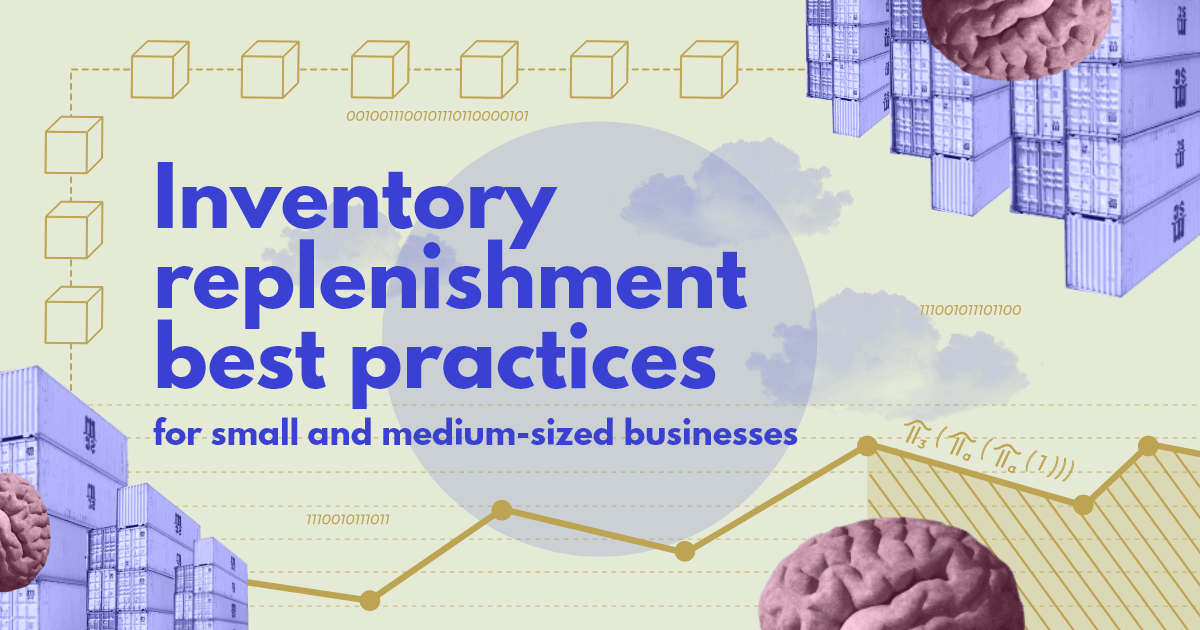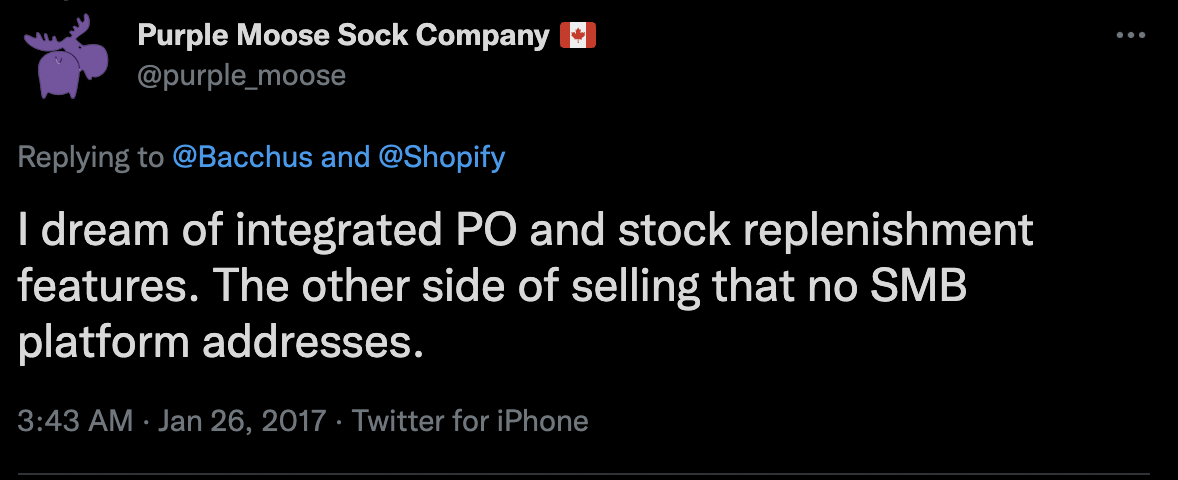Sales forecasting
and inventory optimization
Become a retail mastermind you always wanted to be.
Become a retail mastermind you always wanted to be.
Written by: Jul Domingo
As a consumer, it can be frustrating to find a product you absolutely need—only to discover it’s currently unavailable.
We’ve all been there.
Now consider the scenario as an owner of a small or medium-sized business. Which area of your business should you optimize to avoid letting your target shoppers down?
The answer: Inventory replenishment.
In this post, you can explore how it varies between physical retail and ecommerce SMEs and learn how to overcome some challenges through inventory replenishment best practices.
Inventory replenishment, also known as stock replenishment, is the process of restocking goods as they move through the supply chain while maintaining maximum efficiency and minimizing costs.
“Inventory replenishment more broadly ensures stock is managed in a manner that results in as little disruption to the supply chain as possible.“
– James Khoury, ecommerce fulfillment platform ZendBox CEO
It’s important to maintain your inventory levels so there’s never a shortage and avoid having excess inventory sitting on your shelves or storage spaces. This helps SMBs—physical stores or e-commerce—achieve the following:
Being an SME owner, your limited resources make you more inclined to invest in goods that drive your profits. So the last thing you want is to understock your cash cow and overstock your dead inventory. Unfortunately, 72% of stockouts occur due to inefficient inventory management, including poor replenishment practices.
“Smart inventory replenishment strategies help businesses stay on top of their cash flow by ensuring that they have enough funds at all times,” advises Maria Vasserman, Marketing Specialist at Maropost, an eCommerce and multi-marketing platform. This ensures you have cash on hand when you need it to fulfill orders or pay suppliers.
Surf Gear Lab Founder Marc Bromhall cautions, “If you don’t get inventory replenishment right, you can either end up running out of stock or end up having too much stock, which could result in cash flow issues.”
When you have the right amount of inventory at the right time, you can maximize warehouse space and decrease product misplacement and degradation. That’s on top of preventing the cost of inventory distortion, such as overstocks, shortages, and shrinkage—which amounts to a whopping $1.1 Trillion worldwide.
“Inventory replenishment stops you from stockouts, overstocking, and split shipment, all of which can be extremely costly for retail businesses. The primary purpose of this function is to refill the picking shelves with fresh stocks that can be sold to customers.”
– Chris Nddie, Co-Owner & Marketing Director at ClothingRIC
Stockouts hurt your business more than you realize, especially in terms of customer retention. Aside from losing a potential sale, it can also lead to a poor customer experience for online shoppers when a seller delays shipping or cancels an order due to insufficient inventory. And this isn’t uncommon—34% of businesses have shipped an order late because they sold something that was not in stock.
If you don’t want your business to go belly up, improve your service levels by having a good replenishment practice. According to Alina Clark, an entrepreneur and CocoDoc’s co-founder, “Inventory replenishment is highly important because it ensures you always have enough stock to match the demand at any given time.”
Restocking inventory isn’t the only purpose of a good replenishment plan. It should also:
Inventory replenishment for brick-and-mortar and online can be as different as apples and oranges, as they are two distinct business models.
“Since there are no physical shelves in eCommerce, replenishment here occurs at fulfillment warehouses, so there’s inventory to fill orders. In brick-and-mortar settings, the stock is kept in storage in case the products run low on shelves,” Nddie explains.
Physical stores can keep goods in stockrooms to occupy the shelves once the item count drops. In ecommerce, inventory replenishment takes place immediately once the products hit the warehouses. This distinction can lead to variations in certain factors, such as the amount, volume, and frequency of ordering goods or supplies.
Let’s look at each brick and mortar shop as a tiny warehouse that connects to a central warehouse. Forecasting and replenishment strategy must be done on a smaller scale for each store, not just the warehouse itself—this makes the process more complex than e-commerce.
Another difference is that “inventory replenishment for brick-and-mortar relies more on chance and guesswork compared to eCommerce,” according to Stacy Lewis, an interior designer at furniture brand Eternity Modern. That’s because there’s less data to work with for physical shops. It’s harder to place pre-order requests and track how many customers have searched for out-of-stock products.
“In e-commerce, people expect an out-of-stock item will be available on the website at some point, but it’s not easy to do that when visiting a physical store.”
– Stefania Bulgaru, Megaventory’s Marketing and Communications Officer
In the case of Uncorked Ventures Founder and Wine Club Reviews blogger Mark Aselstine, e-commerce consumers will often accept slightly different products as part of a replenishment cycle if the same product can’t be reproduced. But of course, this depends on the product in question. “Selling wine makes inventory replenishment an interesting concept because there’s actually a limited amount of each wine,” he explains further.
Despite all these differences, they still have a lot in common. For one, “they both have limited amounts of a particular stock that can be sold at a time,” Clark shares. Moreover, they share a lot of the same inventory replenishment challenges, such as:
Inventory replenishment is an integral part of running a physical store and e-commerce business, regardless of its size.
But since SMBs have limited resources, it takes a while for them to perfect the process and overcome the challenges that come with it.
Here are some of the inventory replenishment best practices to get you started.
Demand forecasting or inventory forecasting is a crucial part of inventory management. “Passive demand forecasting is often applied in e-commerce inventory replenishment by using sales data from past years and projecting that in the current scenario,” Nddie explains.
Traditional options exist in the form of various inventory forecasting methods. However, numbers change frequently depending on your customers’ changing needs, making it difficult to keep track and get more accurate results if you do it manually.
Unfortunately, if you snooze, you lose. “Every organization has different ways of managing the flow of products through their supply chain, but no matter how you approach it, having accurate data about where each product is in the process is key,” Vasserman points out.
Here’s where relying on a demand forecasting tool can be a game-changer. Instead of DYI-ing as most SMBs tend to do, you can save time by letting a tried-and-tested system like Inventoro take charge.
Geared with deep learning and sophisticated mathematics, you can forecast your sales and demand just as well as the big physical and online retail players—or maybe even better. We rely on internal competition and always strive to deliver better results for our customers on a daily basis.
As an SME, you deal with different suppliers–and they all have different processes, which leads to varying lead times. Monitoring this can be a handful. But if you don’t pay attention, you’re likely to overlook the time it takes to receive your orders. By the time you realize it, it might be too late.
Moreover, the lead times suppliers provide are just estimates. Disruptions result in inaccurate delivery times, and some suppliers deliver on time while others don’t.
“Both in e-commerce and brick-and-mortar, it’s important to move faster: faster to process an order, faster to order stock to be replenished, faster to receive the stock,” Bulagru points out.
She shares an interesting inventory replenishment tip: Buy the same goods from multiple sources. “That way, if supplier A is out of stock, you can switch to supplier B and replenish, hence shortening restock time,” she adds.
Most companies make it a habit to place frequent orders in an effort to save time and avoid stockouts. However, restocking without gauging the quantities required is usually how the perpetual problem of overstocking begins.
When you first started your business, it was okay to play it by ear. As time went on, you developed a system and started managing your inventory manually and recording it on Excel. That’s fine for the first couple of years—not so much when you want to scale. Manually counting inventory is tiresome and time-consuming, especially if you’re a one-person operation.
Unfortunately, 43% of small businesses in the U.S. fail to track inventory or use manual methods. One of the most critical inventory replenishment tips is not to skimp out on inventory management. You can find a wide range of tools for this purpose, and achieve even more.
For instance, Inventoro helps you keep tabs on your inventory with our product segmentation feature, but it doesn’t stop there. We also work to optimize it by reducing your stocks while boosting sales in the process.
What you put in your warehouse determines your performance. It goes hand in hand with your investment. Figure out which stocks your warehouse or stockroom will hold because, without proper warehouse optimization, it will be harder to bring your inventory replenishment plan to life.
Companies, big or small, find themselves in a constant state of overstocking to meet customer demands. But remember, the more stock you have, the more space you need. Here are some tips to improve your warehouse or storage capacity:
For supply chain optimization, end-to-end visibility is the key. You can delay replenishment if you don’t provide your suppliers with accurate, real-time stock information. If this happens, you won’t hit your target safety stock, which can put a damper on the whole inventory management operation.
It’s not easy to achieve supply chain transparency, but it’s always possible. And you’re better off starting now than after your business has expanded. Take note of each step of the process and gather all relevant data, so you can tap into it when you need information before you take action.
“This means not only knowing what’s coming to a facility (or arriving at distribution centers), but also what’s leaving and when all while keeping tabs on any changes along the way. The more information a business has about these processes, the better,” Vasserman explains.
Inventoro can help in this department. We monitor and maintain your sales data in one place, reflect your service levels through product segmentation, and even replenish your stocks automatically. Furthermore, we integrate with other systems to give you a complete picture of your inventory management needs and performance.
Source: Twitter
Inventory replenishment is a lot of work. This old tweet by a sock brand proves that SMBs need and want to automate their stock replenishment process. And not a lot of platforms offer this functionality, but Inventoro does.
Let’s dive into how our automated inventory replenishment process works:
Inventoro’s forecast tool allows you to see your potential sales. The product segmentation feature shows you the service level for each product—and to cap it off, we also create the perfect purchase order, day in and day out. Other factors such as variable lead times, on-hand inventory, purchase period, trends, seasonality, and much more are also taken into consideration, so they’re not left hanging over your head.
It’s that simple. It saves you—or your staff—brain power and time, focusing on other tasks to scale your business instead of having to repeat the process daily or weekly. You can get a demo to better understand how our system works.
Replenish your inventory accurately and efficiently, request a demo today.
Become a retail mastermind you always wanted to be.

